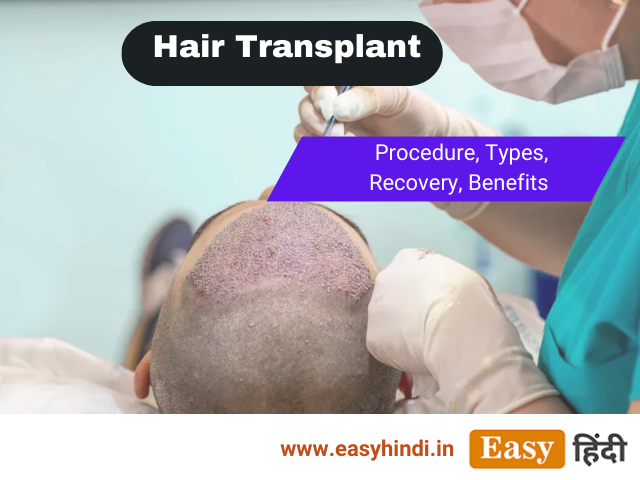One of the most common issues today is hair loss or baldness. The rate of progression is greatly influenced by genetic predisposition, nutritional deficiencies, stress, excessive use of hair products, hard water use, etc. If untreated for a longer period of time, it could result in a permanent loss of hair follicles.
The scalp’s balding areas can regrow hair thanks to hair transplantation. Several clinics make great results their top priority. Before choosing the best location for a hair transplant, it is crucial to conduct research. To learn everything you might need to know before having hair transplant surgery, scroll down.
What is Hair Transplant?
Using your own hair to cover bald spots on your scalp, a hair transplant is a surgical hair restoration technique. There are many methods for doing it; some have negative effects like the FUT and others have positive effects like the FUE.
The only situation where hair transplants are an option is when hair loss is permanent. Men and women alike should think about other options if they want to restore temporary hair loss.
Natural and long-lasting results are achieved. which is the main factor contributing to the procedure’s widespread use. For a sizable segment of patients with hair loss, a hair transplant is an effective baldness treatment. However, there are some things that your surgeon needs to check for before surgery.
Types of Hair Transplant Techniques
The extraction of donor grafts can be done using one of three different hair transplant techniques:
Follicular Unit Transplantation (FUT):
Local anesthesia is given to the patient before the follicular unit transplantation (FUT) procedure, which involves cutting a strip of hair from the back of the head and dividing it into individual grafts to cover the bald spot.
After the hair follicles have been extracted, the surgeon fixes the grafts or hair follicles to the bald area. Following that, the balding area is punctured with tiny incisions made with needles and extremely fine blades.
Following this, the hair grafts that were extracted are inserted into the balding area through small incisions or holes.
Through the use of non-touch techniques and cutting-edge microscopic vision, the surgeon would carry out the FUT procedure without touching the patient’s hair roots. In addition, the surgeon would give careful consideration to the development of your hairline so that you would have a natural appearance appropriate for your age.
Follicular unit extraction (FUE):
During this procedure, the surgeon uses a specialized machine to carefully remove each individual follicular unit from the back of the head.
The surgeon transplants the grafts, or hair follicles, to the bald area once the extraction process is complete. The surgeon then makes tiny incisions in the balding area with the aid of needles and extremely fine blades.
Then, the tiny sites or holes in the balding area are punctured with the extracted hair grafts. For people who have smaller patches of baldness, the FUE procedure is ideal. Fewer scalp incisions and stitches are required with this less invasive procedure.
Under state-of-the-art microscopic vision, the FUE procedure is carried out using non-touch methods without damaging the hair roots. Additionally, skilled surgeons give special consideration to hairline creation in order to give a person a natural appearance that suits his or her age and facial profile.
Direct Hair Transplant (DHT):
A more sophisticated form of FUE, Direct Hair Transplant involves manually extracting each follicular unit from the patient’s donor area using an extractor rather than a motor.
Following that, balding patches are filled with the transplanted follicles that were previously removed. The main distinction between Direct Hair Transplant and FUE is that Direct Hair Transplant does not create reception sites.
Any part of the body, including the patient’s scalp, chest, beard, or pubic region, may serve as the donor area. The placement of the follicles is prioritized by the surgeon in all of these techniques, where the depth, direction, and angle of the grafts are taken into consideration, producing natural aesthetics.
Complications associated with a hair transplant
The majority of hair transplant side effects are minor and go away in a few weeks. They can include:
- bleeding
- Infection
- itching
- Scalp swelling
- A bruise around the eyes
- An area of the scalp where hair has been removed or implanted forms a crust
- There is numbness or lack of sensation in the scalp areas that have been treated
- Hair follicle inflammation or infection, known as folliculitis
- Loss of transplanted hair caused by shock, which is typically temporary
- The appearance of tufts of hair that are unnatural
Benefits of Hair transplant
Listed below are a few advantages of hair transplants:
- For those who are experiencing hair loss, the hair transplant procedure is a permanent solution.
- It provides a texture that resembles the wearer’s natural hair and aids in establishing a natural hairline.
- Since the transplanted hair behaves like natural hair, little maintenance is necessary.
- The patient doesn’t require any special products following the procedure.
- Finally, because it leaves fewer scars, the most recent FUE method produces better cosmetic results.
Possible Side-Effects
Natural hair transplants are typically risk-free operations with minimal to no negative side effects. The majority of any side effects that patients may encounter are temporary and reversible. The following are a few typical side effects of the procedure:
- around the eyes, some light bruising
- inflammation of the scalp
- numbness
- the scalp is itchy
- inflamed hair follicles after transplant
- the scab over the scalp’s donor site
- loss of the transplanted hair momentarily
Recovery Time and Post-Surgical Care
You will be required to take painkillers like an antibiotic or an anti-inflammatory drug for about 5-8 days after the procedure because your scalp might be sore. The surgeon will instruct you to cover your scalp with bandages for at least one or two days.
After 2–5 days following the procedure, the majority of people who choose hair transplantation procedures can resume their jobs. Immediately following surgery, the transplanted hair will fall out, but a few months later, you should start to see new hair growth.
Cost Of Hair Loss Treatment
The price of hair loss treatment in Jaipur is largely based on the various elements that go into the overall process and course of action. Dr. Jagdeep Rao is highly regarded for his knowledge and effectiveness in the field of hair care treatments.
The best doctors to address the issues are those who have a distinctive approach to dealing with the various types of hair loss treatments in Jaipur. Consequently, the price of the treatment would take into account things like:
- An individual’s age
- Hair loss severity
- Treatment option
- How long the Jaipur hair loss treatment will last or how many sessions there will be
- Scans and tests for diagnosis
- The doctor’s fees
How To Treat Hair Loss?
In order to effectively treat hair loss without exacerbating the problem, one must adhere to a strategic plan when receiving hair loss treatment in Jaipur. Before recommending the best hair fall treatment in Jaipur, the best hair doctor in Jaipur will make sure to identify the underlying cause of hair loss.
Most people who frequently worry that a treatment won’t produce noticeable results right away can choose to have a hair transplant to see the results in a shorter amount of time.
Numerous over-the-counter (OTC) products for hair loss claim to be the best treatment available. However, the effectiveness of these products to stop hair loss is minimal. Consult with the top surgeon in Jaipur to determine what is required for your specific hair loss issue rather than wasting your money, time, or effort. Visit Cosmo Care to find the best surgical or non-surgical hair loss treatment by Dr. Jagdeep Rao.
What To Expect From Your Doctor?
People can suffer a great deal of trauma and discomfort as a result of hair loss and other hair issues. To ensure that everyone has access to the best hair transplant in Jaipur, Dr. Jagdeep Rao is providing their services in the city.
Cosmo Care provides numerous hair treatments in addition to a variety of cosmetic services. Research on hair loss as a novel and successful non-invasive hair loss treatment has been conducted in-depth by Dr. Jagdeep Rao.
Ask a ton of questions when you see your Jaipur hair specialist so you can fully comprehend what is happening in and around your scalp when you experience hair loss. At Cosmo Care, the best hair treatment specialist in Jaipur, we make sure that each patient understands the unique challenges that come with hair loss.





